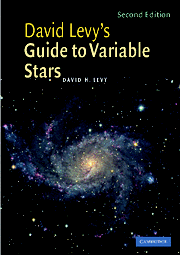Book contents
- Frontmatter
- Contents
- Foreword to the first edition
- Preface
- Acknowledgments
- Part I Getting to know the sky
- Part II Getting to know the variables
- 5 Meeting the family
- 6 Getting started with Cepheids
- 7 Algol, the demon of autumn
- 8 How to estimate a variable
- 9 Names and records
- 10 How your observations help us understand a variable star
- 11 Observing hints
- 12 Observing with CCDs
- 13 Stately and wonderful
- 14 Stars of challenge
- 15 Bright, easy, and interesting
- 16 Betelgeuse: easy and hard
- 17 Not too regular
- 18 Nova? What nova?
- 19 Supernovae
- 20 Clyde Tombaugh's star and the family of cataclysmic variables
- 21 A nova in reverse?
- 22 RU Lupi?
- 23 Orion, the star factory
- 24 Other variable things
- 25 The Sun
- Part III Suggested variables for observation throughout the year
- Part IV A miscellany
- Index
21 - A nova in reverse?
from Part II - Getting to know the variables
Published online by Cambridge University Press: 05 August 2012
- Frontmatter
- Contents
- Foreword to the first edition
- Preface
- Acknowledgments
- Part I Getting to know the sky
- Part II Getting to know the variables
- 5 Meeting the family
- 6 Getting started with Cepheids
- 7 Algol, the demon of autumn
- 8 How to estimate a variable
- 9 Names and records
- 10 How your observations help us understand a variable star
- 11 Observing hints
- 12 Observing with CCDs
- 13 Stately and wonderful
- 14 Stars of challenge
- 15 Bright, easy, and interesting
- 16 Betelgeuse: easy and hard
- 17 Not too regular
- 18 Nova? What nova?
- 19 Supernovae
- 20 Clyde Tombaugh's star and the family of cataclysmic variables
- 21 A nova in reverse?
- 22 RU Lupi?
- 23 Orion, the star factory
- 24 Other variable things
- 25 The Sun
- Part III Suggested variables for observation throughout the year
- Part IV A miscellany
- Index
Summary
R Coronae Borealis
Have you ever had a backwards day, when everything seemed to be happening in reverse, and things turned out to be precisely the opposite of what you expected? Such a day should end with your first observation of a “backwards nova,” a star called R Coronae Borealis.
Usually, a nova stays at minimum until the day of its mighty explosion. R Coronae Borealis does the opposite. It stays at maximum, a bright beacon around magnitude 6, and then without warning plunges eight full magnitudes to the depths of a magnitude 14 minimum. At its brightest it can be seen with a good pair of unaided eyes if the sky is dark enough. At minimum it will test the mettle of a 20 cm (8-inch) telescope.
R Coronae Borealis is not really a nova in reverse; it only acts like one, perhaps by surrounding itself at completely irregular intervals with a shell of carbon particles which absorb light. In late February of 1977, I returned from an evening out and the clouded sky was just beginning to clear. I decided to check the sky and observe just one variable for a total session of no more than ten minutes. I thought I would try R Coronae Borealis since the night before and for many months earlier it had been shining brightly at about magnitude 6. It often happens that my shortest observing sessions turn out to be the most productive.
- Type
- Chapter
- Information
- David Levy's Guide to Variable Stars , pp. 126 - 130Publisher: Cambridge University PressPrint publication year: 2005

